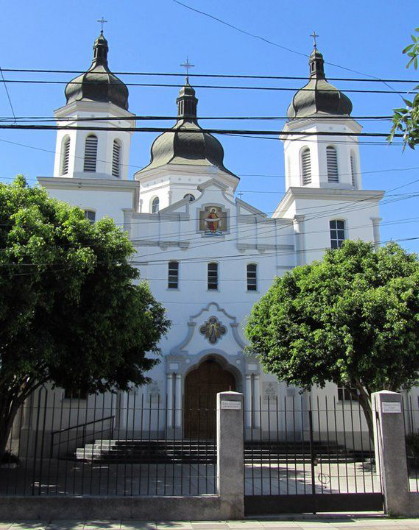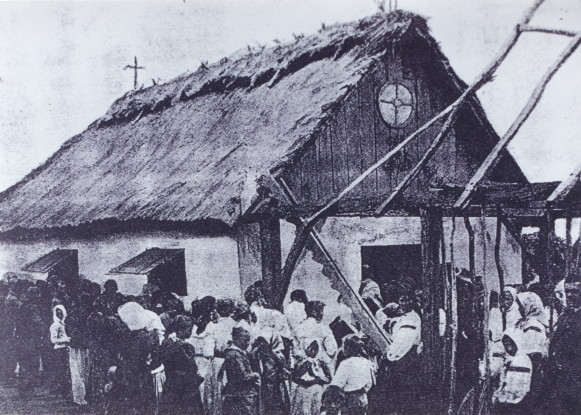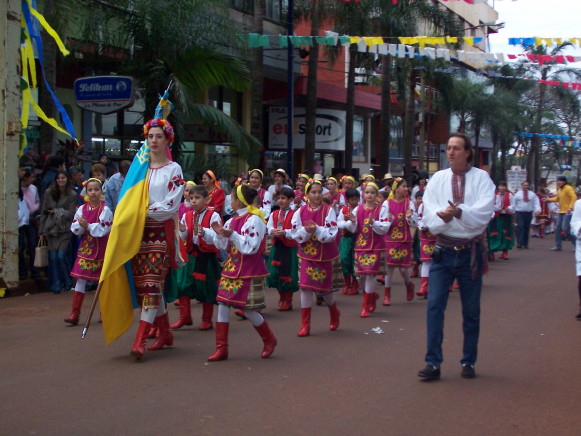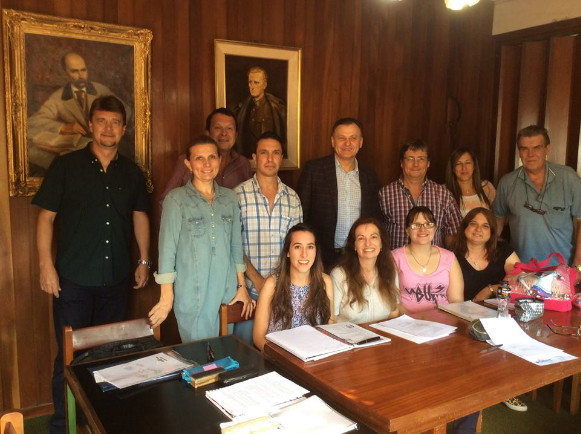Argentina
Argentina. Since 1810 an independent federated republic (2010 pop 40,117,096) composed of 23 provinces and one federal capital district and covering an area of 2,791,800 sq km. Buenos Aires is the capital city. The first documentation of the arrival of Ukrainians in Argentina dates from 1897, when Ukrainian families from Galicia came as permanent settlers to Apóstoles, in the province of Misiones. The immigration of Ukrainians to Argentina may be divided into four distinct periods: 1897–1914, 1922–39, 1946–50, and 1991–2000. The settlers of the first wave included Galician peasants who emigrated from Galicia with their families, often coming equipped with agricultural implements and even seed. Members of this first group emigrated with the intention of settling in the United States of America, but because of difficulties with the United States Department of Immigration they applied for and were granted entry into Argentina. Here they were sent to the northernmost province of Argentina—Misiones—an almost unpopulated region of subtropical forest and pampa, which required cultivation. The new settlers were each sold 50 ha of government land and were allotted food supplies, seed, and agricultural implements, and received other forms of assistance. Ukrainians from other regions also came to Argentina. Some of the Ukrainian immigrants settled in Buenos Aires and its environs, particularly in the town of Berisso. The greatest influx of Ukrainian immigrants to Argentina in this period occurred between 1900 and 1903, and by the First World War both newcomers and their descendants numbered up to 10,000.
The second wave of immigrants (1922–39) was a more varied one. It consisted of Ukrainians from Galicia, Volhynia, Polisia, Transcarpathia, and Bukovyna, as well as political émigrés from central and eastern Ukraine. Up to 70,000 Ukrainians immigrated to Argentina in 1921–39. Members of the intelligentsia, especially former military personnel, immigrated with the peasantry. During this period existing colonies in Misiones, Buenos Aires, and Berisso grew, and new communities developed in the provinces of Chaco, Mendoza, Formosa, Córdoba, Entre Ríos, Santa Fè, Río Negro, etc.
The third period of Ukrainian immigration to Argentina (totaling about 6,000 between 1946 and 1950) was made up of displaced persons from displaced persons camps in Germany and Austria. A large percentage of them were well-educated and professional people. However, because of the economic crisis of 1950–2 and the consequent difficulties in finding work in some fields, a number of these immigrants departed to the United States and Canada. A movement back to the Ukrainian SSR, encouraged by the Soviet Union, also took place in the late 1940s among members of the Sovietophile Ukrainian community. The resulting decreases in the Ukrainian population of Argentina were partially balanced by the resettlement of Ukrainians from the neighboring countries of Paraguay and Uruguay, and by the return from the Ukrainian SSR of a number of disillusioned Sovietophiles who were fortunate enough to obtain the Soviet government’s permission to leave. After 1991, about 10,000 Ukrainians, either temporarily or permanently, moved to Argentina directly from Ukraine.
A lack of statistical data makes it difficult to establish precisely the numerical strength of the Ukrainian population of Argentina. On the eve of the Second World War, based on community sources, the number of Ukrainians and their descendants in Argentina may have totaled approximately 120,000. The overall Ukrainian population of Argentina (including natural population growth) in 2015 could be estimated at up to 400,000. As a result of internal migrations, Ukrainians now inhabit almost all of the Argentinian provinces, with the greatest numbers in the following: Buenos Aires (the capital and the surrounding towns of La Plata, Berisso, Verónica, Punta Indio; Misiones (Apóstoles, Oberá, Posadas, Leandro N. Alem, Las Tunas, etc); Chaco (Sáenz Peña, Villa Ángela, Las Breñas, San Bernardo, etc); Mendoza (Bowen, La Escandinava, Colonia Rusa, etc). There are smaller populations in the provinces of Formosa, Río Negro, Córdoba, Santa Fè, etc.
Religious life. Traditionally, two-thirds of the Ukrainians in Argentina belonged to the Ukrainian Catholic church and less than one-fourth to the Ukrainian Orthodox church. The remainder were Evangelical Baptists, adherents of various sects, or did not specify their religion. Active participation in organized religious life is relatively low, especially in urban areas and in the provinces that had no congregations for an extended period of time.
The Ukrainian Catholics had no clergy of their own during the first 10 years of their settlement in Argentina. Attempts by Poles and Russians to convert Ukrainians to Roman Catholicism or to the Russian Orthodox faith were partially successful. Numerous immigrants who refused to change their faith did not baptize their children or get married or buried by the church. Instead, with their own resources, they built churches and chapels where they gathered for communal prayers. In March 1908, the Basilian priest Rev K. Bzhukhovsky came to Argentina from Brazil at the instruction of Metropolitan Andrei Sheptytsky. He was replaced one year later by Rev. Ya. Karpiak. These two priests succeeded in laying the foundations of an organized church life in the province of Misiones, and their work was continued by Rev. I. Senyshyn (1910–25) and Rev. S. Vaprovych (1927–35). The organization of church life in the province of Buenos Aires was initiated by Rev. I. Maika (1940–50) and continued by the Basilian monastic order with the help of the secular clergy (Rev. I. Baluk and Rev. M. Kunytsky). In 1968 the Vatican created an exarchate for Ukrainian Catholics in Argentina under Bishop Andrii Sapeliak, and in 1978 raised it to the status of an eparchy.
In 1979 the Argentinian eparchy of the Ukrainian Catholic church consisted of 11 parishes, 22 priests (10 Basilians, 5 Salesians, 2 Franciscans, 1 Orionist, and 3 secular priests), and 90 nuns (Basilian order of nuns—75; Sisters Servants of Mary Immaculate—10; Catechist Sisters—5).
In 2014, the eparchy comprised 13 parishes, 20 priests (13 diocesan and 7 religious priests), and 87 nuns. Sviatoslav Shevchuk served as the Apostolic Administrator for Ukrainians in Argentina from 10 April 2010 to 25 March 2011. He was succeeded from 22 June 2011 by Daniel Kozelinski Netto, who was also appointed (2013) Apostolic Visitator for Greek-Catholic Ukrainians in Chile, Paraguay, Uruguay, and Venezuela.
Ukrainian immigrants of the Orthodox faith similarly lacked religious guidance for many years. The first Orthodox center, in the community of Tres Capones in Misiones, was formed by Ukrainian Galicians who converted to the Orthodox church in 1908. Their parish priest, until 1943, was Rev. T. Hnatiuk from Volhynia. The Ukrainian Autocephalous Orthodox church was formally established only in 1946, when a large group of Orthodox immigrants, together with its clergy, arrived in Argentina. Organizational efforts, including the formation of the Orthodox Brotherhood of the Holy Protectress, were begun by Rev. I. Yaroslavsky and continued by Rev. B. Ariichuk and others. The Ukrainian Orthodox church in Argentina fell under the successive jurisdictions of Metropolitan Polikarp Sikorsky in Europe, and Archbishop Ihor Huba and Metropolitan Ioan Teodorovych of the United States. For a time it formed part of the South American eparchy under Yov Skakalsky, a hierarch of the Ukrainian Orthodox Church in the USA. The Orthodox church in Argentina consists of a cathedral in the city of Buenos Aires (Catedral de la Santísima Protección de la Virgen [Pokrova]), and parishes in the Buenos Aires suburbs of San Martín de Tours and Villa Caraza (in Lanús), Berisso in the province of Buenos Aires, and Villa Angela, Las Breñas, La Tigra, and San Bernardo in the province of Chaco. It falls under the jurisdiction of Jeremías Ferens (Curitiba, Brazil), archbishop of the Ukrainian Autocephalous Orthodox church in South America.
The Ukrainian Evangelicals originally belonged to the Slavic Union of Evangelical Christians and Baptists. In 1955, however, on the initiative of M. Bakhor and other pastors, they formed the independent Ukrainian Alliance of Evangelical Christians and Baptists. In early 1979 this association represented three evangelical communities and had its headquarters in Oberá, in the province of Misiones (also the home of the Ukrainian Bible Institute).
Cultural and political life. In Misiones priests were active in the organization of community life. Rev Ya. Karpiak established the first educational body—the Shashkevych Reading Society—in Apóstoles in 1910. O. Ananevych established a similar society in Azara in 1912 and the Ukraina social club in Apóstoles, which has been intermittently active to the present day (now known as the Ukrainian Social Club). Community groups and institutions were organized in other localities throughout Misiones. Such activity gradually decreased, with only sporadic resurgences such as the erection of Taras Shevchenko monuments in Apóstoles and Oberá. Ukrainians in the province of Buenos Aires began an organized community life with the formation of various groups, such as the Moloda Ukraina drama ensemble, formed in Berisso in 1924 and renamed the Prosvita society in the same year. A second Prosvita society was organized at the same time in Buenos Aires, and the two groups joined to form a larger organization which subsequently established branches throughout the province of Buenos Aires as well as in several other provinces. This society could not meet all the needs of the community; hence other groups were formed: in 1931, the Sokil society, devoted to sports and paramilitary activities, and in 1933, the Ukrainian Riflemen’s Hromada, with a paramilitary and political (nationalist) character. Both of these organizations established branches and in 1938 joined together to form the Vidrodzhennia society (until 1939—the Argentinian branch of the Organization for the Rebirth of Ukraine). Prosvita and the Vidrodzhennia society were the two major Ukrainian organizations; other groups formed, but they were relatively short-lived.
The third immigration strengthened the two existing societies and imbued them with differing political orientations of the Organization of Ukrainian Nationalists: the Prosvita society became associated with the OUN (Bandera faction), the Vidrodzhennia society with the OUN (Melnyk faction). New organizations were also created, and the following were still in existence in the 1980s: the Brotherhood of the Holy Protectress and the Ukrainian Catholic Alliance; the youth organizations Plast Ukrainian Youth Association, Ukrainian Youth Association (SUM), and Organization of Ukrainian Youth (OUM); the Union of Ukrainian Veterans (SUVA), the Brotherhood of Former Soldiers of the First Ukrainian Division of the Ukrainian National Army and the Symon Petliura Legion; the cultural organization—Ukrainian Information and Publishing Institute; the political organization Society of Friends of the Ukrainian National Council; women’s organizations—the Ukrainian Women’s Association of Argentina, the Alliance of Prosvita Women, and the Organization of the Ukrainian Women of Vidrodzhennia; and professional organizations—the Association of Ukrainian Merchants, Businessmen, and Professionals, and the Society of Argentinian-Ukrainian Graduates. Each of these organizations, with headquarters in Buenos Aires, and the Sokil society in Córdoba, belonged to the Ukrainian Central Representation in Argentina, an umbrella organization established in 1947 at the first congress of Ukrainians in Argentina. The activities pursued by some of these groups were often very limited. The most varied and dynamic work was done by the two larger societies, Prosvita and the Vidrodzhennia society. They organized schools, libraries, theatrical groups, choirs, resorts, credit unions, and so on. The Sovietophile Ukrainians in Argentina also developed their own organizations, including the Shevchenko Society, the Franko Society, and later the Ostrovsky Society and the Maiakovsky Club. There had been little or no contact between the Sovietophile and nationalist groups.
In 2015 the Ukrainian Central Representation in Argentina embraced the following organizations: the Prosvita society (Asociación Ucrania de Cultura ‘Prosvita’); the Vidrodzhennia society (Asociación Ucraniana ‘Renacimiento’); the Orthodox Brotherhood of the Holy Protectress (Hermandad de la Catedral Santa Virgen de la Iglesia Autocéfala Ortodoxa Ucrania); the Ukrainian Catholic Brotherhood of Saint Sophia (Hermandad Santa Sofía de la Eparquía Santa María del Patrocinio Bonaerense de los Ucranios de rito bizantino-ucranio); Plast Ukrainian Youth Association (Asociación Ucrania Juvenil PLAST); Ukrainian Youth Association (SUM) (Asociación Juvenil Ucrania CYM); the Taras Shevchenko Foundation (Fundación Tarás Shevchenko); the Society of Argentinian-Ukrainian Graduates (Asociación de Graduados Universitarios Argentino Ucranios); the Alliance of Prosvita Women (Unión de Mujeres de Prosvita); the Organization of the Ukrainian Women of Vidrodzhennia (Organización de Mujeres ‘Renacimiento’); the Ukrainian Women’s Association of Argentina (Unión de Mujeres Ucranias); the 27th of August Ukrainian Cultural Association (Asociación Cultural Ucrania ‘27 de Agosto,’ Posadas, Misiones); the Argentine-Ukrainian Social Club (Club Social Argentino-Ucranio, Apóstoles, Misiones); The Ukrainian Community of Oberá and Colonies (Colectividad Ucrania de Oberá y Colonias, Misiones); the Slavna Ukraina Argentine-Ukrainian Association (Asociación Civil Argentino-Ucrania Slavna Ukraina, Resistencia, Chaco); the Sokil society (Asociación Ucrania ‘Sokil’, Córdoba); the Ukrainian Alliance of Evangelical Christians and Baptists (Hermandad Ucrania Evangélico Bautista); the Brotherhood of Former Soldiers of the First Ukrainian Division of the Ukrainian National Army (Hermandad de ex-combatientes de la 1º División del Ejército Nacional Ucranio); and the Argentine-Ukrainian Chamber of Commerce and Industry (Cámara Argentino-Ucrania de Comercio e Industria).
Economic life. Early settlers in Misiones suffered great hardships in adapting to the unfavorable subtropical climate, fighting banditry, and the like. Nevertheless, in a short time they were actively involved in agriculture and cattle raising, activities initially geared only to the fulfillment of basic family needs. With time, however, a more monocultural type of market farming was developed. Today Ukrainian farmers in Misiones cultivate primarily tea (yerba maté), rice, oranges and lemons, and, in some areas, sugar cane and cotton. The provinces of Chaco and Formosa produce cotton, sorghum, and corn; forestry is also important there. In the province of Mendoza, the primary agricultural activities are viticulture and fruit cultivation; in Río Negro, fruit cultivation, forestry, and the cultivation of hops; and in the provinces of Buenos Aires, Santa Fè, and Entre Ríos, the cultivation of wheat, corn, and other grains.
In urban areas immigrants initially worked either in the most physically demanding manual jobs (in railroad, subway, and port construction or as unskilled factory labor), or as janitors, domestics, seasonal laborers, etc. In a relatively short time many of them acquired the necessary qualifications for better jobs. The number of skilled and professional people increased significantly with the third immigration. Ukrainian industrial and commercial enterprises were established, and service agencies of various kinds appeared.
Many young Ukrainians have taken advantage of the fact that Argentina provides free university education, and the Ukrainian community has produced a significant number of graduates in professional fields.
Schools and education. Ukrainian schools in Argentina are mostly supplementary Saturday or Sunday schools. In the early 1990s there were four full-day schools (two in Apóstoles, one in Posadas, one in Berisso), under the administration of the Basilian monastic order; the language of instruction was Spanish. Most of the supplementary Ukrainian schools are sponsored and operated by the Prosvita society and the Vidrodzhennia society and by the church parishes. The first Ukrainian school was organized in 1910 by Rev I. Senyshyn in Apóstoles. In 1967 there were about 300 children enrolled at the elementary level in about 20 schools in metropolitan Buenos Aires and in Berisso. The courses are taught by laymen, priests, and nuns. In 1979 the number of schools in Buenos Aires dropped to 15, and enrollment to 200. Ukrainian studies at the secondary and higher levels have been offered at the Buenos Aires branch of the Ukrainian Catholic University (Rome) since 1967.
The youth organizations engage in some educational work. The main activities of these organizations are periodic meetings, summer camps, sports programs, folk-dancing instruction, and the like.
Press, publishing, radio. Since 1927 about 20 Ukrainian newspapers and periodicals appeared in Argentina, the most important of which were the following: the weeklies Ukraïns’ke slovo (Buenos Aires) (ed M. Danylyshyn) and Nash klych (eds Yevhen Onatsky and M. Fesolovych); the religious monthlies Zhyttia (Argentina) (ed Rev V. Kovalyk), Dzvin (ed Rev B. Ariichuk), and Ievanhel’s’ka zirka (ed M. Bakhor); the community and literary monthlies Ovyd (ed Mykola Denysiuk) and Porohy (ed Ihor Kachurovsky); the humorous and satirical monthly Mitla (ed Yu. Serediak); and irregular periodicals such as Ucrania Libre (a Spanish-language review, ed E. Martínez Codo). Only Ukraïns’ke slovo and Nash klych survived, as the official organs of the Prosvita society and Vidrodzhennia society respectively. The M. Denysiuk Publishing Co was active from 1949 to 1960; the Yu. Serediak Publishing Co was also prominent. Newspaper and journal editorial boards put out occasional publications, as have various other institutions.
The first Ukrainian radio program, ‘Vilna Ukraina,’ was established through the efforts of V. Ivanytsky and Lidiia Makarukha. Subsequently, other programs appeared, among them Ukrainian cultural programs, aired on the national radio station. Initially Ukrainian-language programming was permitted; however, a bill passed later by the government allowed Spanish-language broadcasting only. The Ukrainian Central Representation in Argentina maintains a homepage on the internet: http://www.rcucrania.com.ar/language/es/.
Art, literature, scholarship. Few Ukrainians were active in the arts or scholarship in Argentina before 1947, with the exception of the prominent graphic artist, painter, and caricaturist Viktor Tsymbal, who came to Argentina with the first wave of immigrants. A significant number of artists and scholars settled in Argentina between 1947 and 1949, but the majority of them either emigrated or died soon after. Among the individuals who were active in the arts were the painters Borys Kriukov, Oleksander Klymko, Volodymyr Lasovsky, L. Hrytsai, O. Hurska, V. Kaplun, A. Sokil; the sculptors Kost Buldyn, Petro Kapshuchenko, M. Holodyk; and the architects Yu. Shulminsky and V. Hrynenko. Literary figures of note included Anatol Halan, Oleksa Satsiuk, Ihor Kachurovsky, and Yevhen Onatsky; personalities in Ukrainian theater included H. Hryhorenko, V. Maksymets, A. Kabantsiv, T. Lykholai, O. Khlebych, Halyna Andreadis, M. Holodyk; and in music the pianists Taras Mykysha and V. Suprun and the violinists the Chumachenko brothers. In choral music the choir Surma (conductor V. Vasylyk) and the National Choir (conductor I. Kopitović, a Croatian) are worthy of mention. In 2011, according to the homepage of the Ukrainian embassy in Buenos Aires, there were around 20 Ukrainian dance ensembles, choirs, and bandura capellas in the provinces of Buenos Aires, Misiones, and Santa Fé.
The following were prominent in the area of scholarship in Argentina: Yurii Poliansky, a professor of geology at the University of Buenos Aires; Bohdan Halaichuk, a professor of international law at the Catholic University in Buenos Aires; the literary scholar and folklorist Yevhen Onatsky; and the soil scientist I. Bandura. There were other university professors: Yu. Shulminsky, M. Livsha, M. Vasylyk, I. Lypynsky, and I. Shyian. In the 1950s the majority of individuals involved in the arts or sciences were members of the Association of Ukrainian Scholars, Litterateurs, and Artists.
Ukrainians in the economic and social life of Argentina. In cultivating the virgin lands, the Ukrainian immigrants made a great contribution to the development of the Argentinian national economy, especially in the provinces of Misiones, Chaco, and, to a lesser extent, Mendoza. Their contribution to industrial development was small, however.
Participation in the social and political life of the country is evident primarily in the provinces of Misiones and Chaco, where Ukrainians were involved in the local government. Among these public figures were the long-time mayors of Apóstoles Rev I. Senyshyn and O. Varenytsia, the mayor of San Bernardo (in Chaco) A. Baluk, the senator R. Hnatiuk, and the Roman Catholic bishop L. Kruk. Bohdan Halaichuk was an advisor in the Ministry of Foreign Affairs. Others more recently included cousins Eugenio Juzwa and Néstor Juzwa (the former mayor of Berisso in 1991–95 and the latter mayor of Berisso in 1995–2003), and the late Mariano Balanda (federal member of parliament and minister of health in Misiones).
The assimilation of Ukrainians in Argentina has been quite pronounced. The consequences of this process are seen primarily in the decline of Ukrainian culture and in the lack of participation in organized forms of ethnic life. In the 1990s, a renewed ethnic consciousness was evident among Ukrainians, particularly in the Catholic community.
In 1991, following the 1991 Ukraine’s Declaration of Independence, Argentina was the first Latin American country to recognize Ukraine, on 5 December 1991. Ukraine opened an embassy in Buenos Aires in March 1993. Argentina opened an embassy in Kyiv in May 1993. Honorary consulates of Ukraine were established in the provinces of Misiones and Chaco.
BIBLIOGRAPHY
Karmans'kyi, P. Mizh ridnymy v Pivdennii Amerytsi (Vienna 1933)
Vaprovych, S. Argentina: Ukraïns'ka emigratsiia v nii (Lviv 1935)
Sapeliak, A. Ukraïns'ka Katolyts'ka Tserkva v Argentyni (Buenos Aires 1972)
Serhiichuk, Rev S. ‘25 rokiv Bratstva sv. Pokrovy,’ Dzvin, no. 6/240 (Buenos Aires 1972)
Shliakhyts'kyi, H. ‘Ukraïntsi v Misiones,’ Al’manakh ‘Zhyttia’ (Apóstoles 1972)
Danylyshyn, M. Ukraïntsi v Argentyni (Buenos Aires 1979)
Vasylyk, M. Ukraïns'ki poselennia v Argentyni (Munich 1982)
———. Immigración ucrainia en la República Argentina: Una comunidad por dentro (Buenos Aires 2000)
Cipko, S. Ukrainians in Argentina, 1897–1950: The Making of a Community (Edmonton and Toronto, 2011)
Stemplowski, R. Ed. Polacy, Rusini i Ukraińcy, Argentyńczycy. Osadnictwo w Misiones 1892–2009 (Warsaw, 2011)
Serge Cipko, Mykhailo Vasylyk
[This article was updated in 2017.]


.jpg)
.jpg)
.jpg)


